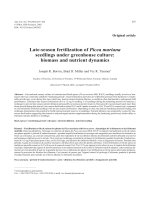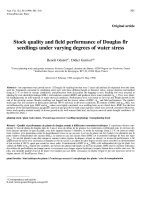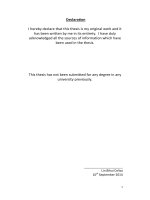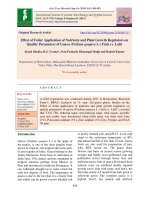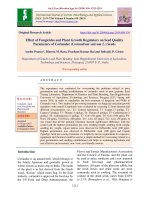Effect of growth regulators and Chemicals on germination and growth of rangpur lime seedlings under nursery condition
Bạn đang xem bản rút gọn của tài liệu. Xem và tải ngay bản đầy đủ của tài liệu tại đây (170.62 KB, 6 trang )
Int.J.Curr.Microbiol.App.Sci (2020) 9(3): 836-841
International Journal of Current Microbiology and Applied Sciences
ISSN: 2319-7706 Volume 9 Number 3 (2020)
Journal homepage:
Original Research Article
/>
Effect of Growth Regulators and Chemicals on Germination and Growth of
Rangpur Lime Seedlings under Nursery Condition
S. V. Yadav1*, M. B. Patil2 and K. D. Mahorkar1
1
Department of Horticulture, College of Agriculture, Badnapur, VNMKV,
Parbhani, 431 402 (M.S.), India
2
Fruit Research Station Himayat Bagh Aurangabad, (M.S.), India
*Corresponding author
ABSTRACT
Keywords
Rangpur lime, GA3,
KNO3, NAA,
Thiourea,
Germination and
growth
Article Info
Accepted:
05 February 2020
Available Online:
10 March 2020
The present investigation entitled “Effect of growth regulators and chemicals on
germination and growth of rangpur lime seedlings under nursery condition”was
carried out at the Instructional Cum Research Farm, sweet orange research station
Badnapur, Dist- Jalna during the year 2016- 2017. The experiment was laid out in
Randomized Block Design with thirteen treatments replicated thrice. The seeds
will be soaked in different concentrations of GA3 (50, 100 and 150 ppm), KNO3
(0.5%, 1%, 2%), NAA (50,100 and 150 ppm) Thiourea (1%, 1.5% and 2%) water
soaking as control for 24 hours in beaker. The results of the investigation revealed
that,the seeds soaked in GA3 150 ppm solution for 12 hours prior to sowing
resulted in maximum germination percentage (91.33 %). The maximum height
(52.12 cm), maximum number of leaves (46.59), maximum fresh weight (31.35 g)
and dry weight of shoots (16.40 g) was also recorded under the treatment T3 i.e.
GA3 150 ppm at 270 DAS. The maximum number of branches (6.66) was
recorded under the treatment T12 i.e. Thiourea 2% at 270 DAS and the maximum
circumference of stem (22.23 mm), was recorded under the treatment T 6 i.e. NAA
150 ppm at 270 DAS.
Introduction
the tree evolved in Hawaii as an ornamental,
when the top graft died off.
The Rangpur lime (Citrus limonia Osbeck) is
a member of the Rutaceae family. It is a citrus
fruit with a very acidic taste and an orange
peel and flesh. The fruit is polyembryonic and
usually reproduces true to seed. A popular
rootstock in many citrus growing locations,
Citrus fruits have a prominent place among
popular and extensively grown tropical and
sub-tropical fruits. They are highly regarded
for their nutritive value, wholesome nature,
medicinal values and economic significance
836
Int.J.Curr.Microbiol.App.Sci (2020) 9(3): 836-841
Citrus fruits possess greater adaptability to
different climatic conditions. Internationally
citrus plantation in the world is confined to 0400 latitude from North to South of the
equator covering different regions having
different soil and climatic conditions. It shows
the wide adaptability of citrus to different soil
and climatic conditions.
ppm) Thiourea (1%, 1.5% and 2%) water
soaking and control for 24 hours in beaker.
The sinkers were sorted out from the floaters.
The seeds will be dry for 10 minutes in shade
after soaking. The dried seeds will be sown in
trays, the trays will filled with soil: sand:
FYM 1:1:1. Seed germination will be
calculated as the proportion of germinated
seedlings to the number of seeds sown and
expressed in terms of percentage. Seedlings
will be transferred to the polythene bags after
germination.
Citrus fruits are the one of the world‟s most
important fruit crop and are consumed mostly
as fresh produce, juice, squashes, cordial and
pickles. Citrus fruits have many merits. They
are available throughout the year. They are
not only delicious and refreshing to eat, but
also provide vitamins, minerals and many
other essential substances, which are required
for human health. They are specially
important for growing children and are an
important source of vitamin „C‟, which plays
a vital role in prevention of scurvy.
Sowing of treated seeds
The treated seeds were sown in trays which
were properly filled, labeled with tags and
placed as per layout. Randomization was
followed to treatment distribution in
replications; every treatment included 100
seeds of Rangpur lime. The treatments were
replicated thrice.
Major citrus producing states in India are
Andhra Pradesh, Maharashtra, Madhya
Pradesh,
Punjab,
Gujarat,
Rajasthan,
Karnataka, Assam, Odisha, Haryana and
others. In India, citrus is the third most
important fruit crop, after mango and banana,
with an estimated production of 11655.20 mt
(in „000‟MT) of fruits and area coverage of
953.40 (in „000‟ ha) during 2014-15. In
Maharashtra production is 1454.27mt (in
„000‟MT) and area coverage of 187.41 ha
(„000‟ ha) (Anon, 2015).
Seed treatment (soaking) and sowing was
attended as per the following details.
Soaking
Date
30-05-16 to 31-05-2016
Time
9.00 pm to 9.00 am
Sowing
Date
Time
Materials and Methods
31-05-2016
The experiment was carried out at the
Instructional Cum Research Farm, sweet
orange research station Badnapur, Dist- Jalna
during the year 2016- 2017. The experiment
was laid out in Randomized Block Design
with thirteen treatments replicated thrice. The
seeds will be soaked in different
concentrations of GA3 (50, 100 and 150 ppm),
KNO3 (0.5%, 1%, 2%), NAA (50,100 and 150
9.00 am to 11.00 am
Results and Discussion
Seed germination percentage
The results regarding seed germination
percentage are presented in table 1. The data
revealed that, there was significant difference
with respect to percentage of seed
837
Int.J.Curr.Microbiol.App.Sci (2020) 9(3): 836-841
germination as affected by different chemical
treatments under study. Maximum percentage
of seed germination (91.33%) was obtained
under the treatment T3 (GA3 150 ppm), which
was significantly superior over control and
rest of the treatments, while minimum seed
germination percentage (65.67%) was noticed
in the treatment T13 i.e. control. The
promotive effect of GA3 on seed germination
might be due to its participation in the activity
of alpha-amylase which catalyses the starch
conversion into simple carbohydrates and
chemical energy is liberated which is used in
the activation of embryo (Shepley et al.,
1973).
ppm (44.37), which was at par with the
treatment T3. The minimum number of leaves
per plant was obtained under the treatment T13
i.e. control (32.35), which was statistically at
par with the treatment T10 i.e. Thiourea 1%
(34.57). Increase in number of leaves in GA3
150 ppm might be due to maximum height of
seedlings under this treatment. This also helps
in invigoration of physiological process of
plant stimulatory effect of chemicals to form
new leaves at faster rate as suggested (Sharma
et al., 1999 and Kadam et al., 2010).
Number of branches per plant
The results regarding number of branches per
plant are presented in table 1. More number of
branches per plant (6.66) was produced in the
treatment T12 i.e. Thiourea 2%, which was
significantly superior over control and rest of
the treatments. Less number of branches per
plant (3.46) was produced in the treatment T13
i.e. control. The number of branches per plant
was increased due to effect of thiourea
because of its cytokinin like activity which
suppresses the apical growth by stimulating
lateral buds (Freez, 1978).
Height of plant
At the final stage of observation i.e. 270 days
after sowing, the maximum plant height
(52.12 cm) was produced by the treatment T3
i.e. GA3 150 ppm, which was significantly
superior over control and rest of the
treatments under study.
The next best treatment was T6 (51.31 cm) i.e.
NAA 150 ppm and T2 i.e. GA3 100 ppm
(50.17cm). In remaining treatments also the
plant height was significantly more over
control. Significantly minimum plant height
(39.64 cm) was produced under the treatment
T13 i.e. control as presented in Table 1.More
plant height in GA3 might have occurred due
to cell division (Stowe and Yamaki, 1957)
and cell elongation (Shanmugavelu, 1970),
which in turn would have increased the
internodal length.
Circumference of stem
The treatment T6 i.e. NAA 150 ppm recorded
more circumference of stem (22.23 mm),
which was significantly superior over all
other remaining treatments, except the
treatments T5 (21.45 mm) and T3
(21.44
mm), which were statistically at par with the
treatment T6. Less circumference of stem was
recorded under the treatment T13 i.e. control
(12.38 mm), which was statistically at par
with the treatment T10 i.e. Thiourea 1 %
(13.25 mm) as presented in Table 2.
Number of leaves per plant
The results regarding number of leaves per
plant are presented in table 1. At 270 DAS,
the maximum number of leaves per plant was
produced under the treatment T3 i.e. GA3 150
ppm (46.59), which was significantly superior
over control and rest of the treatments under
study, except the treatment T2 i.e. GA3 100
The increase in circumference of stem with
NAA and GA3 may be due to cell expansion
rather than cell division (Mishra and Verma,
1980).
838
Int.J.Curr.Microbiol.App.Sci (2020) 9(3): 836-841
Table.1 Effect of growth regulators and chemicals on Percentage of seed germination, Height of
plant, number of leaves andnumber of branches per plant
Tr.
No.
T1
T2
T3
T4
T5
T6
T7
T8
T9
T10
T11
T12
T13
Treatment
GA3 50 ppm
GA3 100 ppm
GA3 150 ppm
NAA 50 ppm
NAA 100 ppm
NAA 150 ppm
KNO3 @ 0.5 %
KNO3 @ 1 %
KNO3 @ 1.5 %
Thiourea @ 1%
Thiourea @ 1.5 %
Thiourea @ 2 %
Control
SEm±
CD@5%
Percentage of
seed
germination
88.08
88.66
91.33
79.00
88.10
82.67
84.33
88.11
79.67
78.67
76.33
77.33
65.67
1.19
3.46
Height of plant
after
(270
days)
50.15
50.17
52.12
43.12
50.02
51.31
42.46
42.10
50.08
40.60
40.88
41.54
39.64
1.08
3.15
No. of leaves after
(270 days)
39.40
44.37
46.59
36.63
39.33
44.39
36.10
36.48
39.41
34.57
34.70
35.65
32.35
0.80
2.34
Number of
branches
per plant
4.80
5.10
5.30
5.40
5.60
5.66
4.46
4.66
5.46
6.00
6.26
6.66
3.46
0.30
0.89
Table.2 Effect of growth regulators and chemicals on Circumference of stem, fresh weight of
shoot and Dry weight of shoot
Tr. No.
T1
T2
T3
T4
T5
T6
T7
T8
T9
T10
T11
T12
T13
Treatment
GA3 50 ppm
GA3 100 ppm
GA3 150 ppm
NAA 50 ppm
NAA 100 ppm
NAA 150 ppm
KNO3 @ 0.5 %
KNO3 @ 1 %
KNO3 @ 1.5 %
Thiourea @ 1%
Thiourea @ 1.5 %
Thiourea @ 2 %
Control
SEm±
CD@5%
Circumference
of stem (cm)
17.40
18.47
21.44
19.84
21.45
22.23
18.45
18.59
16.96
13.25
14.42
16.40
12.38
0.048
0.93
839
fresh weight of
shoot (gm)
25.76
27.97
31.35
22.15
23.47
28.41
20.68
20.90
24.19
18.19
18.90
19.40
15.44
1.23
3.60
Dry weight of
shoot (gm)
14.42
15.61
16.40
13.15
13.17
15.71
9.23
10.25
10.68
8.69
8.88
9.12
6.81
0.48
1.41
Int.J.Curr.Microbiol.App.Sci (2020) 9(3): 836-841
number of leaves per plant, fresh and dry
weight of shoots was maximum with the seed
treatment of GA3 at 150 ppm. The remaining
growth attributes like circumference of stem
was maximum with the seed treatment of
NAAat 150 ppm.
Fresh weight of shoots
The results regarding fresh weight of shoots
are presented in table 2. In Rangpur lime
significantly more fresh weight was produced
by the treatment T3 i.e. GA3 150 ppm (31.35
g), followed by the treatments T6 (28.41 g)
and T2 (27.97 g) over control and rest of the
treatments. Significantly less fresh weight of
shoots was observed under the treatment
control (15.44 g). This seems to be the effect
of mobilization of water and nutrients
transported at higher rate which might have
promoted more production of photosynthetic
product and translocated them to various plant
parts which have resulted in better growth of
seedlings and hence more fresh weight (Brain
et al., 1954 and Shanmugavelu, 1966).
References
Anonymous, 2015. Horticulture Statistics at a
glance, Govt. of India, MoA,
Department of Agriculture and
Cooperation, New Delhi.
Brain, P.W. (1954). Effect of gibberellins on
plant growth and development. Biol.
Rev. 34: 37-84.
Freez, A. 1978. Thiourea a growth promoter
of callus tissues J.Exp. Bot. 29 (108):
159-165.
Kadam, A.B., Singh, D.B. and Kade, R.A.
(2011). Effect of plant growth
regulators and potassium nitrate on
growth of seedling of Rangpur lime.
International Journal of Agricultural
Sciences, 7 (1): 96-99.
Shanmugavelu, K.G. (1966). Studies on the
effect of plant growth regulator on the
seedling of some tree plant species.
South Indian Hort.14:24-25.
Shanmugavelu, K.G. (1970). Effect of
gibberellic acid on seed germination
and development of seedling of some
tree species. Madras Agric. J.
57(6):311-314.
Sharma, M.C., Ughreia, P.P.U. and Jambukia,
T.K. (1999). Effect of some plant
growth regulators, chemicals and
organic waste on germination and
subsequent seedling growth of kagzi
lime
Stowe, B.B. and Yamaki, T. (1957). The
history and physiological action of the
gibberellins. Ann. Rev. Plant Physio.
8: 181-216.
Dry weight of shoots
The results regarding dry weight of shoots are
presented in table 2. Significantly more dry
weight of shoots was recorded in the
treatment T3 i.e. GA3 150 ppm (16.40 g),
followed by the treatments T6 (15.71 g) and
T2 (15.61 g), over control and rest of the
treatments. Significantly minimum dry weight
of shoots was obtained under the treatment
control (6.81g). This seems to be the effect of
mobilization of water and nutrients
transported at higher rate which might have
promoted more production of photosynthetic
product and translocated them to various plant
parts which have resulted in better growth of
seedlings and hence more fresh weight and
dry weight (Brain et al., 1954 and
Shanmugavelu, 1966).
On the basis of present investigation the
following conclusion can be drawn. Effect of
growth regulators and chemicals has got
significant effect on seed germination,
vegetative growth of rangpur lime. The
maximum percentage of seed germination and
the growth attributes like height of plant,
840
Int.J.Curr.Microbiol.App.Sci (2020) 9(3): 836-841
How to cite this article:
Yadav, S. V., M. B. Patil and Mahorkar, K. D. 2020. Effect of Growth Regulators and
Chemicals on Germination and Growth of Rangpur Lime Seedlings under Nursery Condition.
Int.J.Curr.Microbiol.App.Sci. 9(03): 836-841. doi: />
841

